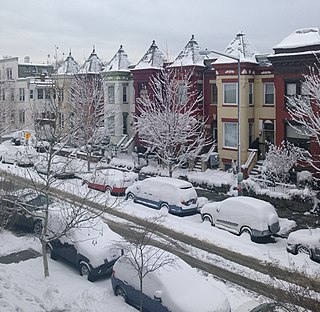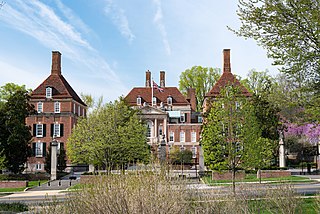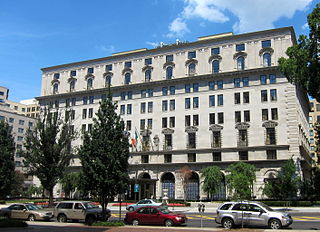
The Financial District of Lower Manhattan, also known as FiDi, is a neighborhood located on the southern tip of Manhattan island in New York City. It is bounded by the West Side Highway on the west, Chambers Street and City Hall Park on the north, Brooklyn Bridge on the northeast, the East River to the southeast, and South Ferry and the Battery on the south.

Bloomingdale is a neighborhood in the Northwest quadrant of Washington, D.C., less than two miles (3 km) north of the United States Capitol building. It is a primarily residential neighborhood, with a small commercial center near the intersection of Rhode Island Avenue and First Street NW featuring bars, restaurants, and food markets.

Harry Wardman was a real estate developer in Washington, D.C. during the early 20th century whose developments included landmark hotels, luxury apartment buildings, and many rowhouses. When he died in 1938, one-tenth of the residents of Washington were said to live in a Wardman-built home.

Woodley Park is a neighborhood in Northwest, Washington, DC. It is bounded on the north by Woodley Road and Klingle Road, on the east by the National Zoo and Rock Creek Park, on the south by Calvert Street, on the southwest by Cleveland Avenue, and on the west by 34th Street.

The Downtown Miami Historic District is a U.S. historic district located in the CBD of Downtown Miami, Florida. The district is bounded by Miami Court, North Third Street, West Third Avenue, and South Second Street. It contains 60 historic buildings. A large portion the buildings in the historic district were built during the Florida land boom of the 1920s, when Miami experienced rapid population growth. Many of the older structures from before the 1920s, were smaller scale buildings and homes from the Miami pioneer era of the mid and late-19th century. Palm Cottage, built in 1897 is a home from the pioneer era that is still standing, however, few of these original homes remain.

The Frank Lloyd Wright/Prairie School of Architecture Historic District is a residential neighborhood in the Cook County, Illinois village of Oak Park, United States. The Frank Lloyd Wright Historic District is both a federally designated historic district listed on the U.S. National Register of Historic Places and a local historic district within the village of Oak Park. The districts have differing boundaries and contributing properties, over 20 of which were designed by Frank Lloyd Wright, widely regarded as the greatest American architect.
Fort Stevens Ridge is a neighborhood in Northwest Washington, D.C. built during the 1920s. The neighborhood comprises about 50 acres (0.20 km2) and is very roughly bounded by Peabody Street, Fifth Street, Underwood Street, and Ninth Street. As of the 2010 census, the neighborhood had 2,597 residents. It was named for nearby Fort Stevens, a Civil War-era fort used to defend the nation's capital from invasion by Confederate soldiers.

Mihran Mesrobian was an Armenian-American architect whose career spanned over fifty years and in several countries. Having received an education in the Academy of Fine Arts in Constantinople, Mesrobian began his career as an architect in Smyrna and in Constantinople. While in Constantinople, Mesrobian served as the palace architect to the last Ottoman Sultan, Mehmed V.

The Sixteenth Street Historic District is a 1.25 mile (2.01 km) linear historic district in Washington, D.C., that includes all structures along 16th Street NW between H Street and Florida Avenue. The district's southern boundary is bordered by Lafayette Square, just north of the White House, and Meridian Hill Park on its northern boundary. It includes an eclectic mix of architectural styles on one of the city's most historic and important numbered streets including single and multi-family residential buildings, embassies, hotels, churches, and office buildings. Most of the district's oldest structures are religious and residential buildings, while many of the commercial buildings were built in the early to mid-20th century. The stretch of 16th Street between Scott Circle and Florida Avenue was recognized as a historic district in 1978 and listed on the National Register of Historic Places, and in 2007 it was expanded to include buildings south of Scott Circle to H Street. The historic district is also listed on the District of Columbia Inventory of Historic Sites.

The Strivers' Section Historic District is a historic district located in the Dupont Circle neighborhood of Washington, D.C. Strivers' Section was historically an enclave of upper-middle-class African Americans, often community leaders, in the late 19th and early 20th centuries. It takes its name from a turn-of-the-20th-century writer who described the district as "the Striver's section, a community of Negro aristocracy." The name echoes that of Strivers' Row in Harlem, a New York City historic neighborhood of black professionals. The district is roughly bounded by Swann Street and the Dupont Circle Historic District on the south, Florida Avenue and the Washington Heights Historic District on the north and west, and the Sixteenth Street Historic District on the east.

The 2225 N Street Apartment Building in the West End neighborhood of Northwest Washington, D.C., was constructed in 1924 by local real estate developers Harry Wardman and Eugene Waggaman. The building was added to the District of Columbia Inventory of Historic Sites in 1990 and the National Register of Historic Places in 1994.

The Washington Marriott Wardman Park is a defunct convention hotel located at 2600 Woodley Road NW, in the Woodley Park neighborhood of Washington, D.C.. The hotel is on Connecticut Avenue and is adjacent to the Woodley Park station of the Washington Metro. The 1,152-room hotel contains 195,000 square feet (18,100 m2) of total event space and 95,000 square feet (8,800 m2) of exhibit space. It opened in 1918 and closed in 2020, due to the economic impact of the COVID-19 pandemic. The owners filed for bankruptcy in 2021 and announced plans to sell the property for redevelopment.

This is a list of the National Register of Historic Places listings in Center City, Philadelphia.

There are 69 properties listed on the National Register of Historic Places in Albany, New York, United States. Six are additionally designated as National Historic Landmarks (NHLs), the most of any city in the state after New York City. Another 14 are historic districts, for which 20 of the listings are also contributing properties. Two properties, both buildings, that had been listed in the past but have since been demolished have been delisted; one building that is also no longer extant remains listed.

The British Ambassador's residence in Washington, D.C. is located at 3100 Massachusetts Avenue, Northwest, Washington, D.C. in the Embassy Row neighborhood.

The St. Regis Washington, D.C. known for many years as The Carlton Hotel, is an historic hotel located at 923 Black Lives Matter Plaza in Washington, D.C. two blocks north of the White House.

Clifton Terrace are historic structures located in the Columbia Heights neighborhood in the Northwest Quadrant of Washington, D.C. Frank Russell White and Albert Moreland Schneider designed the three building apartment complex in the Colonial Revival style. They were inspired by the garden city movement. Harry Wardman built the complex from 1914–1915 along the 14th Street streetcar line. It was listed on the National Register of Historic Places in 2001.

The Cathedral Mansions Apartment Buildings are historic structures located at 2900, 3000, and 3100 Connecticut Avenue NW in the Woodley Park neighborhood of Washington, D.C. Constructed from 1922 to 1924, architect Eugene Waggaman designed the Connecticut Avenue apartment buildings in the Classical Revival style for developer Harry Wardman. Architect Mihran Mesrobian's initials appear on a drawing for one of the buildings.

Stockton Hall is a building on the campus of George Washington University in Washington, D.C.. It was listed on the District of Columbia Inventory of Historic Sites in 1987 and on the National Register of Historic Places in 1991.

Frank Russell White was an American architect who designed hotels, apartment buildings, commercial properties, and thousands of homes in Washington, D.C. A native of Brooklyn, White's family moved to the nation's capital during his childhood. Although he had no formal training, White was tutored by local architect Albert H. Beers and designed thousands of buildings for developer Harry Wardman.






















